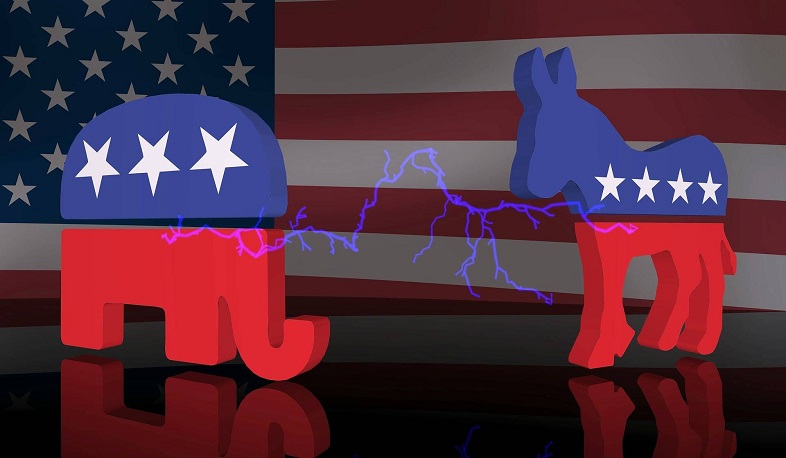Mid-Term Elections: changes in the political atmosphere

Recent events
In the last few weeksa series of events in the United States have altered the political atmosphere that prevaileduntil a little over a month ago. This introduced changes in the state of opinion of a not negligible segment of people and affected the perception that was recently held regarding the mid-term elections coming up next 8 November.
These events have had favorable results for the Democratic Party and detrimental ones for the Republican Party.In favor of the former, there has been a change in the general perception that things have finally begun to move and promises have begun to be fulfilled.
In this regard the following can be noted:
Finally, after lengthy negotiations with Senator Joe Manchin (D-WV), the Democratic Party reached an agreement on a bill, the Inflation Reduction Act of 2022, to be voted on in Congress.This billincludes a sizable part of Biden’s plan known as Build Back Better, which was approved on August 7 51-50, with Vice Chairwoman Harris voting in favor. The passage of this bill will allow the Biden Administration to make the largest investment ever in this country to reduce the effects of climate change and to challenge through Medicare the prices currently imposed by large drug companies.
A few days later, Biden won passage of a bipartisan bill (The Chips and Science Act), designed to stimulate semiconductor manufacturing in the United States.
With bipartisan support, the «Burn Pits Act» was passed to expand medical benefits to veterans who had been exposed to toxic fumes on military bases.
At the end of June, after difficult negotiations with the Republicans, Biden won the approval of a bipartisan bill on arms control, which, although still far from contemplating essential aspects that have majority support among the population, it is the most important legislation achieved in the last 28 years.
Also, invoking his executive powers, Biden fulfilled his long-standing promise to alleviate the burden of debts that college students have had to incur in order to meet the high costs of their careers. This executive order will eliminate debts of up to $20,000.
At the end of August, Biden traveled to Pennsylvania where he promoted his Safer America plan to provide federal funds to localities that need to hire police officers and invest in crime prevention and mental health strategies. The plan could take on up to 100,000 new officers and is a strong antidote to those who accuse Democrats of being weak on crime and wanting to underfund the police.
In addition, on 1 August, Biden announced that the United States had killed in a drone strike Ayman al-Zawairi, who had taken over the leadership of al-Qaeda after the death of Osama bin Laden. This announcement, presented as a great triumph, attempted -and to some extent succeeded -in somewhat countering the unfavorable repercussions caused by the disastrous US withdrawal from Afghanistan.
But as is often the case, the economy is the main issue for most voters, and although some important indices have shown a slight improvement, both the situation of Americans today and the prospects for the short and medium term future are quite uncertain. This continues to be the fundamental cause of the low acceptance that the Biden Administration stillgarners. The assessments almost always differ considerably depending on the publication in question and the experts consulted, especially when referring to Democratic or Republican «specialists».
However, some aspects are less questionable. Inflation, the number one concern of Americans, has decreased slightly in recent weeks. The price of a gallon of gasoline, which in some states was over 5 dollars, has dropped in the last two months and is now around 3 dollars 50. Unemployment figures continue to remain low at approximately 3.5% which is among the lowest in the nation’s history.
Although still feeble, the winds are currently blowing in favor of Biden and the Democratic Party. The results of the next elections will largely depend on how those windscontinue to blow this September and in October, although there is no guarantee that this trend will be sustained. The war in Ukraine could raise fuel prices again. Food prices have barely eased and some economists insist on pointing to the possibility of a looming recession in the economy.
On the Republican side the winds have been blowing in the opposite direction. Donald Trump continues to dominate the party but his hold has been somewhat diminished in recent months. While most of the candidates he has endorsed in primaries have won their contests, others have lost. Some of the candidates who won are inexperienced political outsiders, extremists who still insist that Biden did not win the election, and even some are persons who have in some way participated in or supported the 6 January events on Capitol Hill. For this reason, some analysts expect that, especially in swing states, more than one of these will lose to their Democratic opponents. The differences between the more orthodox and traditional Republicans and the Trumpists, whom they call MAGA (Make America Great Again), have widened and it is expected that a far from negligible number of them, as well as independents, come November will probably prefer to vote for a moderate Democrat rather than for an extremist MAGA. All of this contributes to the structural damage of the party.
In fact, Biden and many Democratic candidates are focusing their campaigns on the dangers these MAGAs pose to the country and the democratic principles that govern it. In his recent message to the nation Biden said:
«Equality and democracy are under assault…Donald Trump and Republican MAGA’s represent an extremism that threatens the foundations of our republic, and there is no doubt that today the Republican Party is dominated, manipulated and intimidated by Donald Trump…the assault on Capitol Hill was a failed attempt to prevent the peaceful transition of power after the 2020 elections in preparation for the 2022 and 2024 elections.»
A recent NBC News poll, reflected in Ben White’s article «Team Biden’s Dour Mood Eases as Gas Prices Fall» published in POLITICO on August 29, found that the biggest concern Americans express right now is «threats to democracy,» surpassing the economy and inflation for the first time in many months. Another CBS poll from early September indicates that 64% of respondents believe that political violence will increase in the coming years. Trump’s belligerent rhetoric, with phrases such as «Biden is an enemy of the State» and «this vile political class must be crushed or the country will be destroyed» provide constant fuel to the fire. It should come as no surprise, then, that in the aftermath of the events on Capitol Hill, a January 2021 CBS/YouGov poll found that 49% of Republicans consider Democrats as»enemies» while 47% of Democrats consider Republicans as «enemies».
Another event that has proved detrimental to the Republican Party is the FBI raid on Donald Trump’s Mar-A-Lago residence in Florida to seize documents. This at first united many Republicans in condemning the action but that unity has begun to crack after the revelation that an enormous amount of documents classified as secret and very secret, even some with nuclear information from other countries compromising agents or informants, were kept by Trump kept in his house without authorization putting national security at risk. Once the work of reviewing the documents is concluded and shows whether or not the tycoon violated the espionage law, he will not be able to aspire to the presidency of the country again, as everything seems to indicate that he intends to do.
Before going on to analyze the primaries, let us look at an important event not directly attributable to either party, but which undoubtedly has enormous repercussions on people, particularly women, and will be reflected in the November elections: the decision of the Supreme Court last June to reverse the law known as Roe v Wade, which guaranteed the constitutional right to abortion, and dealt a mortal blow to that right attained by women 50 years ago.
Some 63% of the adult U.S. population has spoken out against this measure, and particularly among women the percentage should be higher. But it is also a highly sensitive issue that will surely mobilize a growing number of voters who will express their positions by voting against the Republicans who most of them have always been against this law and who elevated to the Supreme Court the conservative judges who reversed it.
A preview of this situation could be seen in a recent election held in the conservative state of Kansas where, to the surprise of most of those familiar with these issues, an amendment to the state constitution that sought to deny the right to abortion was overwhelmingly defeated. It was reported that after the Supreme Court decision, the percentage of women who registered there to vote increased by 70%. Something similar happened in nine other states, with Pennsylvania and Ohio standing out, though with lower percentages than in Kansas. An August 23 Pew Research Center poll revealed that 56% of registered voters consider the abortion issue «very important» for this midterm election and some believe that the issue has energized both Democrats and independents.
Let’s take a look at how all of these developments have impacted the upcoming midterm elections by the results of some primaries and thecriteria of voters as reflected in various polls.
In the article Turn out Surge Powered Democrats’NY Special Election Win – and Their Renewed Hopes for November, by Jessica Piper, Ally Mutnick and Bill Mahoney published in POLITICO, August 24, the authors express that in New York’s 19th district, Democrat Pat Ryan and Republican Marc Molinarostood against each other in an election viewed as a sort of referendum on Biden and his administration. Molinaro’s victory was expected, but Ryan finally won by 2 points over his rival, where the most significant result was the high number of Democrats who came out to vote.
Something similar occurred in another New York district, as well as in races that took place in Nebraska and Minnesota. Republican challengers were expected to prevail, but by surprisingly narrow margins the opposite occurred, as Democratic challengers scored several points above those obtained by Biden in 2020 and Republicans fell below the margins obtained by Trump.
Additionally in Alaska, one of the most Republican states in the country that Biden lost by 10 points, Democrat Mary Peltola defeated Sarah Palin and another Republican in a special election for a House seat, marking the first time that a Democrat has won an election for statewide office in Alaska.
Considerations and forecasts
Regarding the impact of the aforementioned events on the voters’ criteria we can check that the important approval rating for President Biden’s administration, which during the first half of the year dropped to below 40%, has been rising and is now around 44% according to Gallup, and 43% according to Five Thirty Eight. That indicates an increase of about 5 points, something that does not usually happen a few months before a mid-term election, and which the experts highlight, although they also point out that 53% of the population disapproves of his administration.
Particularly relevant, as revealed by both Gallup and Morning Consult, is that the approval of Biden’s administration has risen 9 points among the important population segment of independents.
Another criterion that has undergone changes is that the population’s perception of Biden’s handling of the economy has also risen 9 points since July: from 28% to 37%.
The important element of motivation to vote has also changed. Various polls and expert opinions show a notable increase in the motivation of Democrats to participate in the November 8 elections, especially after, and as a consequence of, the reversal of the abortion rights law, but also because of the danger that a Republican victory would represent for democracy and the security of the country. Generally, lack of motivation and low voter turnout by the governing party in mid-term elections is one of the causes of the losses they usually suffer in this kind of elections, something that might not happen this time.
No less important, and in line with the previous paragraph assertion, the change experienced in the generic vote reveals the impact of recent events on the electorate. Thissection of the vote, which until very recently was firmly on the Republican side, according to Amy Walter, of the influential Cook Political Report, in an article published on September 6, is currently 47% to 43% in favor of the Democrats.
All of the above have a corresponding effect on ratings, opinions and forecasts regarding the upcoming mid-term elections.
With reference to the House of Representatives, there is full agreement of opinions in the sense that there is currently a much more favorable atmosphere for the Democrats than there was two months ago. There is also unanimity among all pundits, analysts and the press as to the predictions that the House of Representatives will pass to Republican control. While a few Democratic officials dance around the possibility of retaining control of the lower House, and other Republicans talk of winning 40 seats or more, the near totality of the rest, based more on analysis than on wishful thinking, differ only on the magnitude of the eventual Republican victory, ranging from single-digit wins to 30 seats.
Elements considered in this regard include the fact that a shift of just 5 seats from Democrats to Republicans would be enough for the latter to win a majority. Also the fact that 31 Democratic representatives will not seek re-election, compared to only 18 Republicans, is an element to be taken into account considering that seats defended by incumbents are less likely to change parties. Another important factor against the Democrats is the final result of gerrymandering or redistricting, since the Republicans finally managed to benefit from seats in some states, including Florida and New York where they dominated; in the former, the proposals of Governor De Santis and in New York the changes introduced after the judges rejected the Democratic proposal.
Elements favoring the Democrats are also noted, such as the fact that according to the Cook Political Report, Democratic candidates generally have higher approval ratings than the President. A factor whose scope and importance is always very difficult to assess appears in an article by Jessica Piper published in POLITICO on 8 September under the title «GOP Donor pool unexpectedly shrinks as midterms near», where she states that the number of people who have been donating money to Republican candidates has fallen sharply in the first half of the year. Likewise, the already mentionedgo-out-to-vote energy surge among Democrats, especially after the abortion law reversal and the dangers of MAGA Republicans in more political offices, is a factor to be considered.
The Cook Political Report at the end of August estimates that 10 Democratic seats have a good chance of going Republican, while only 3 Republicans are inclined to go Democratic. The report concludes by saying that while two months ago it was estimated that Republicans would win between 15 and 30 seats, it now estimates that the gain will be between 10 and 20 seats.
Sabato’s Crystal Ball, for its part, states that its analysis of last July gave the Republicans a lead of between 18 and 20 seats, and currently estimates that the difference in their favor is in the order of 15 seats.
For Five Thirty Eight, the Democrats’ chances of winning the House two months ago was 13%, now it is 20%, and they consider the Republicans’ favorites to win the majority in the Lower House to be in the order of 75%.
Nathan Gonzales, in an article published in ROLL CALL on 7 September, considers the possibility of a single-digit Republican victory, and points out that such a narrow lead would make the House virtually ungovernable.
All these experts agree that the current situation and forecasts could change in one direction or another, considering that there is still more than a month and a half to go before the elections and that these next few days are always decisive, but without considering the possibility of a Democratic victory, excluding exceptional situations that are currently unimaginable.
In relation to the Senate, the estimates and forecasts are much more complex. There are 35 seats at stake; 14 currently held by the Democrats and 21 by the Republicans. In a previous work published in Juneby this author, The consideration was that there were 9 key states, all or almost all of which (depending on the criteria of various experts) were in so-called swing states;those would be the ones that would decide which party would gain control of the Senate. This consideration is still fully valid today.
The 4 Democratic states are Arizona, Georgia, New Hampshire and Nevada, all defended by incumbent senators. The Republicans would be 5: Florida, Wisconsin, Pennsylvania, North Carolina and Ohio. Of these only Florida and Wisconsin will be held by incumbent senators while the other 3 are open seats.
We will briefly take a look at the current situation, always bearing in mind that at the moment there are very few polls and surveys whose results in most cases show extremely narrow differences, so that in practice they offer no margin of safety to consider. Of the Democrats, only in Arizona have there been some polls with significant margins in favor of the incumbent. In the other 3 states there have been hardly any polls and surveys, but in all cases the results show minimal advantages for the incumbents, seats that nonetheless, especially in the cases of Georgia and Nevada, are still considered vulnerable and are currently viewed as tied by most experts.
In the case of the Republican states, in Florida Marco Rubio continues to enjoy a relatively comfortable lead in the polls, although in the most recent ones the gap between him and Democratic challenger Val Demings has narrowed (even to just 3 points in the latest one). Demings is getting a lot of support from her party and has raised considerable amounts of money, she has prestige as a former police chief in Orlando, and is one of the final candidates on Biden’s list as a possible running mate. For now, however, Rubio is still considered the frontrunner.
In Wisconsin the incumbent Johnson does not have much prestige and even some polls show him slightly behind the Democratic challenger. Nonetheless, for now the polls in Wisconsin favor the Republican Party. We have not seen polls from North Carolina, but both parties there have acceptable candidates and the odds are currently considered to be 50-50 percent. The cases of Pennsylvania and Ohio are different. In the former the Democratic candidate is a man of the left but with a lot of prestige in the state where he is currently lieutenant governor, while his rival is a doctor and TV show host with no political experience who only got in because he was nominated by Trump. Polls so far give the Democrat a favorable margin of up to 18 points according to Public Opinion Strategies’ August survey. Although some analysts see it 50-50, others believe that the Democrats will win Pennsylvania.
In the case of Ohio, the situation is very similar, the difference being that Ohio has clearly leaned Republican in recent years, which is why it is considered by some to be a tie and favorable to the Republicans by others.
The veteran and well-known analyst Charlie Cook, in his article The Coin is in the Air for the Senate, published on 25 August in the Cook Political Report, says: «Regarding the Senate, the coin is definitely in the air. The Upper House could be 50-50 or either party could win a seat or two by a slim margin of votes.»FiveThirtyEight, for its part, says: «The Senate is definitely up for grabs.” This same source, which in June 30 gave the Democrats a 47% chance of winning the Senate, is currently giving them a 69% chance, and predicting 51 Democratic seats and 49 Republican seats.
Sabato’s Crystal Ball, in its latest forecast sees 49 seats for the Democrats, 49 for the Republicans and 2 ties, Georgia and Nevada.
As things stand today, all specialists agree that what happens in the Senate will depend fundamentally on what happens next in the country and in the framework of the elections in the key states. Apparently the changes that have taken place in the political atmosphere in recent weeks do not seem to have had much influence on the forecasts for the Upper House, with the exception perhaps of Five Thirty Eight. However, in our view there are factors, such as what has happened with the abortion bill that should encourage more people to register and vote for Democratic candidates. Also the low quality of some of the Republican candidates and the fears that MAGA extremists inspire should, to a certain extent, motivate some voters, mainly independents, to vote Democratic. Considering that the elections will be decided by narrow margins in swing states, leads us to believe that at this point the scales are tipping, albeit slightly, in the direction of a Democratic win in the Senate.
Concluding Summary
In recent weeks, political developments have taken place in the United States that to some extent favor the Democratic Party. Some of these are: a slight decline in inflation, especially in fuel; very low unemployment figures; the passage by Congress of legislation that addresses much of Biden’s socio-economic programs;a few unexpected primary victories; the Supreme Court’s decision to reverse the law protecting women’s right to abortion, and Republican miscues due to the dangerous approaches and attacks by Trump and many of his supporters, which endanger the stability of the nation and its political system, as well as the election of some of those inexperienced supporters who share his more extreme positions, to face Democratic opponents. All of this has resulted in changes in the perception of the political situation in the country and the mid-term elections. Indeed, in some of the latest polls, “threats to security and democracy “ has replaced inflation as Americans’ number one concern.
Assessments of the president’s performance, though still low, have risen by about 5-6 points (9 among independents); from less than 40% approval to 43-45%; and regarding his handling of the economy, opinions have risen 9 points, from 28% to 37%. Interest in turning out to vote in the November 8th election, which only a few weeks ago was heavily in favor of the Republicans, is now virtually even. The substantial generic vote index that favored the Republicans by several points now shows 47% to 43% in favor of the Democrats.
On the other hand, not all estimatesseem positive for the Democrats (43-45% approval and almost 57% disapproval are insufficient). Inflation remains high, especially food prices, and forecasts for the economy arenot rosy.
What happens between now and 8 November will be decisive. Anything relevant, even if it were to favor the Democratic Party, would hardly change the prognosis for the House of Representatives. Although Democratic prospects look better today than they did a few weeks ago, especially as interest in voting and voter registrations are increasing, they still seem insufficient to give them victory.
Things are differentIn the Senate. For most pundits the odds are still 50-50 for each party, although some of these and other pundits consider them slightly in favor of the Democrats. Again, what happens in the next 50 days is likely to determine which party will win control of the upper house.




Déjanos tu comentario